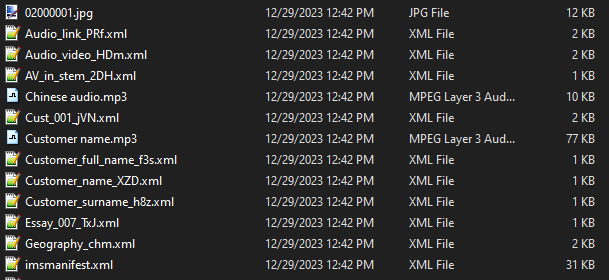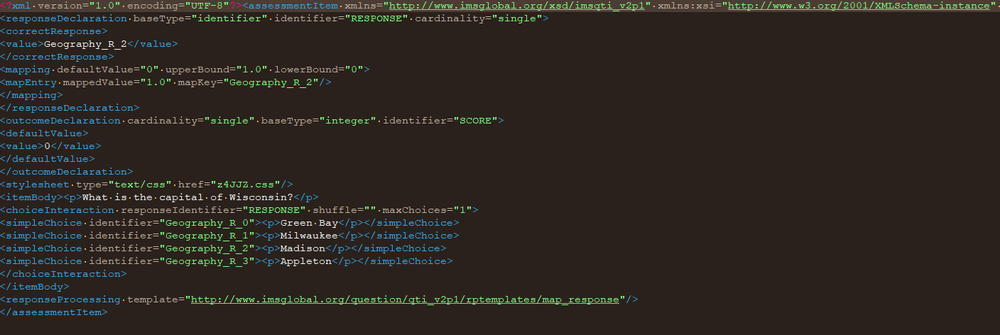Question and Test Interoperability® (QTI®) is a set of standards around the format of import/export files for test questions in educational assessment and HR/credentialing exams. This facilitates the movement of questions from one software platform to another, including item banking, test assembly, e-Learning, training, and exam delivery. This serves two main purposes:
- Allows you to use multiple vendors more easily, such as one for item banking and another for exam delivery;
- Migrating to a new vendor, as you can export all your content from the old vendor then move into the new vendor easily.
In this blog post, we’ll discuss the significance of QTI and how it serves helps test sponsors in the world of certification, workforce, and educational assessment.
What is Question and Test Interoperability (QTI)?
QTI is a widely adopted standard that facilitates the exchange of assessment content and results between various learning platforms and assessment tools. Developed by the IMS Global Learning Consortium / 1EdTech, its goal is that assessments can be created, delivered, and evaluated consistently across different systems, paving the way for a more efficient and streamlined educational experience. QTI is similar to SCORM, which is intended for learning content, while QTI is specific for assessment.
QTI uses an XML approach to content and markup, specifically modified for the situation of educational assessment, such as stems, answer, correct answers, and scoring information. Version 2.x creates a zip file of all content, including a manifest file that lets the importing platform know what’s supposed to be coming in, with items then as separate XML files, and media files saved separately, sometimes into a subfolder.
Here is an example of the file arrangement inside the zip:

Here is an example of what a test question would look like:

Why is QTI important?
Interoperability Across Platforms
QTI enables educators to create assessments on one platform and seamlessly transfer them to another. This cross-platform compatibility is crucial in today’s diverse educational technology landscape, where institutions often use a combination of learning management systems, assessment tools, and other applications.
Enhanced Efficiency
With QTI, the time-consuming process of manually transferring assessment content between systems is eliminated. This not only saves valuable time for educators but also ensures that the integrity of the assessment is maintained throughout the transfer process.
Adaptability to Diverse Assessment Types
QTI supports a wide range of question types, including multiple-choice, true/false, short answer, and more. This adaptability allows educators to create diverse and engaging assessments that cater to different learning styles and subject matter.
Data Standardization
The standardization of data formats within QTI ensures that assessment results are consistent and easily interpretable. This standardization not only facilitates a smoother exchange of information but also enables educators to gain valuable insights into student performance across various assessments.
Facilitating Accessibility
QTI is designed to support accessibility standards, making assessments more inclusive for all students, including those with disabilities. By adhering to accessibility guidelines, educational institutions can ensure that assessments are a fair and effective means of evaluating student knowledge.
How to Use QTI
Creating Assessments

QTI allows educators to author assessments in a standardized format that can be easily transferred between different platforms. When creating assessments, users adhere to the specification, ensuring compatibility and consistency.
Importing and Exporting Assessments
Educational institutions often use multiple learning management systems and assessment tools. QTI simplifies the process of transferring assessments between different platforms, eliminating the need for manual adjustments and reducing the risk of data corruption.
Adhering to QTI Specifications
To fully leverage the benefits of QTI, users must adhere to its specifications when creating and implementing assessments. Understanding the QTI schema and guidelines is essential for ensuring that assessments are interoperable across various systems. This is dependent on the vendor you select. Note that there have been different sets of QTI standards that have evolved over the years, and some vendors have slightly modified their own format!
Examples of QTI Applications
Online Testing Platforms
QTI is widely used in online testing platforms to facilitate the seamless transfer of assessments. Whether transitioning between different learning management systems or integrating third-party assessment tools, it ensures a smooth and standardized process.
Learning Management Systems (LMS)
Educational institutions often employ different LMS platforms. QTI allows educators to create assessments in one LMS and seamlessly transfer them to another, ensuring continuity and consistency in the assessment process.
Assessment Authoring Tools
QTI is integrated into various assessment authoring tools, enabling educators to create assessments in a standardized format. This integration ensures that assessments can be easily shared and used across different educational platforms.
Resources for Implementation
IMS Global Learning Consortium
The official website of the IMS Global Learning Consortium provides comprehensive documentation, specifications, and updates related to QTI. Educators and developers can access valuable resources to understand and implement QTI effectively.
QTI-Compatible Platforms and Tools
Many learning platforms and assessment tools explicitly support these specifications. Exploring and adopting compatible solutions simplifies the implementation process and ensures a seamless experience for both educators and students. Our FastTest platform provides support for QTI.
Community Forums and Support Groups
Engaging with the educational technology community through forums and support groups allows users to share experiences, seek advice, and stay updated on best practices for QTI implementation. See this thread in Moodle forums, for example.
Wikipedia
Wikipedia has an overview of the topic.
Conclusion
In a world where educational technology is advancing rapidly, the Question and Test Interoperability specification stands out as a crucial standard for achieving interoperability in assessment tools, fostering a more efficient, accessible, and adaptable educational environment.. By understanding what QTI is, how to use it, exploring real-world examples, and tapping into valuable resources, educators can navigate the educational landscape more effectively, ensuring a streamlined and consistent e-Assessment experience for students and instructors alike.

Nathan Thompson earned his PhD in Psychometrics from the University of Minnesota, with a focus on computerized adaptive testing. His undergraduate degree was from Luther College with a triple major of Mathematics, Psychology, and Latin. He is primarily interested in the use of AI and software automation to augment and replace the work done by psychometricians, which has provided extensive experience in software design and programming. Dr. Thompson has published over 100 journal articles and conference presentations, but his favorite remains https://scholarworks.umass.edu/pare/vol16/iss1/1/ .

